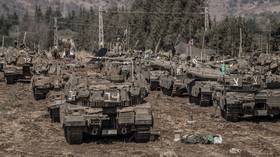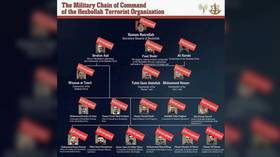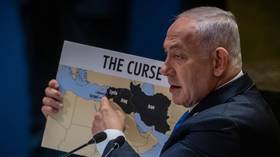[
The assassination of Hassan Nasrallah leaves Lebanon, Iran and Israel itself at a crossroads, where a turn toward chaos would be all too easy
Sheikh Hassan Nasrallah, the leader of the Hezbollah movement, was killed in an Israeli airstrike targeting the southern suburbs of Beirut. This incident occurred amid the escalating conflict between Israel and the Palestinian group Hamas in Gaza. Hezbollah had been actively supporting the Palestinians by launching attacks on Israeli territories from southern Lebanon.
The confrontation between Israel and Hezbollah dates back to the 1980s, when the Lebanese Shiite group was formed, reportedly with Iranian support. Major conflicts arose during the Israeli invasion of Lebanon in 1982, amid the civil war in the country, after which Hezbollah began its active resistance.
One of the largest clashes between the two sides was the 2006 Lebanon War, also known as the ‘War of Shadows’, which was triggered when Hezbollah captured two Israeli soldiers, leading to an Israeli invasion of Lebanon. The war lasted 34 days and ended with a fragile ceasefire, backed by UN Resolution 1701, which called for the disarmament of Hezbollah and the withdrawal of its forces north of the Litani River. However, despite the ceasefire, Hezbollah maintained its armed forces and continued to receive significant support from Iran, strengthening its influence in Lebanon and the region.
Tensions between the parties periodically escalated, with both sides regularly attacking the other. However, after the attack by Palestinian groups on Israel on October 7, 2023, and the onset of the conflict in Gaza, Hezbollah voiced its support for Hamas, leading to exchanges of fire with Israel and increased military activity along the Lebanon-Israel border.
The Israeli authorities repeatedly stated that any attacks from the north would receive a harsh response, and they began ramping up strikes on Hezbollah positions, including its headquarters in Beirut. For nearly a year after the start of the Gaza conflict, tensions along the Lebanese-Israeli border intensified. Despite diplomatic efforts and attempts by mediating countries such as the US and France to establish a ceasefire, both sides continued to exchange fire.
The assassination of Nasrallah marked the culmination of these escalations and is likely to significantly alter the dynamics in the region, increasing the risk of a broader conflict between Israel and Lebanon. Following Nasrallah’s death, Hezbollah vowed to continue its struggle until Israel ceases its aggression against the Palestinians and Lebanon. However, the Israeli armed forces have managed to eliminate 18 high-ranking Hezbollah leaders, including Nasrallah, within less than a year. The loss of its leader and a significant portion of its command could weaken the coordination of Hezbollah’s military actions and destabilize the domestic situation in Lebanon.
Can Israel eliminate Hezbollah?
The military operations undertaken by Israel against Hezbollah that began in October 2023 have marked a significant strategic move for Benjamin Netanyahu’s government. The conflict with Hezbollah aims to enhance security measures along the northern border, where the Lebanese group has regularly shelled Israeli cities in response to Israel’s extensive airstrikes on Lebanon.
However, Israel’s goals extend beyond merely suppressing Hezbollah’s military activities; it also seeks to bolster internal support for Netanyahu’s government, which has faced significant backlash due to protests against judicial reforms, criticism over the mishandling of the Gaza war, and economic stagnation. As reported by the Financial Times, support for Netanyahu’s government returned to pre-October 7 levels following the new military operations in Lebanon and Syria, including the pager attacks against Hezbollah. The Likud party, which had seen a decline in popularity in the wake of the Palestinian attacks, began to regain ground after the assassination of senior Hezbollah and Hamas leaders in Beirut and Tehran. It is evident that the elimination of Nasrallah will positively reflect on Netanyahu’s approval ratings and his administration.
Netanyahu is also addressing long-term objectives, aiming to weaken Iran’s influence in the region. Hezbollah serves as a vital ally for Iran, and targeting its infrastructure in Lebanon undermines Tehran’s position. Israeli military operations have become part of a broader strategy to counteract Iran’s attempts to expand its presence in the Middle East, a move that poses a direct threat to Israeli security. Israel has already eliminated over 500 Hezbollah fighters and several commanders, including Ibrahim Aqil, the leader of Hezbollah’s elite Radwan forces.
Despite international calls for a ceasefire, Israel continues to escalate military actions against Hezbollah. Israeli officials assert that the primary goal remains the destruction of Hezbollah’s military infrastructure and the prevention of its plans to invade Israeli territory. Reports from the Jerusalem Post indicate that the Israeli command has mobilized the 6th and 228th reserve brigades for operations in northern Israel amid rising tensions along the Lebanon border. Commanders have stated that mobilizing these forces will enable the continuation of the fight against Hezbollah.
Nevertheless, many are concerned that a ground operation may yield ambiguous results for Israel itself. Like Hamas, Hezbollah is an organization rooted in the idea of resistance against the West and Israel. The elimination of its leadership does not guarantee the weakening of the organization itself; rather, it could radicalize the sentiments of its supporters. Moreover, even the assassination of Nasrallah does not spell the end for the group, as discussions about a successor are already underway. That successor is likely to be Sayyed Hashem Safieddin, Nasrallah’s cousin and a member of Hezbollah’s executive committee.
Simultaneously, the international environment remains extremely tense, as Israel’s military actions could provoke further Iranian intervention. Nonetheless, Netanyahu continues to advocate a hardline approach, emphasizing that the security of his nation is paramount. Support for the government’s actions among Israelis is increasing, particularly among right-wing political factions that view these measures as steps toward bolstering national security.
Israel’s ongoing actions against Hezbollah, including a potential invasion of Lebanon, could lead to significant military losses for the IDF, as the Lebanese group is more advanced than Hamas, with capabilities that were apparent even in the 2006 war. Regardless of how the situation evolves, completely eliminating Hezbollah seems unlikely. However, should events take a negative turn, the Middle East may face heightened tensions, potentially dragging Iran into a larger conflict alongside global players, particularly the United States.
This situation is likely to have adverse effects on Israel itself. Moody’s has already announced a downgrade of Israel’s credit rating from A2 to Baa1 with a negative outlook. This is the second downgrade during the military operations, following a previous reduction from A1 to A2 in February.
Lebanon and Iran at a crossroads
The assassination of Nasrallah is not only a significant event for Hezbollah but also for Lebanon and the wider region, raising numerous questions about the future of the military-political situation both domestically and externally. The event could lead to serious internal and external repercussions. Already, Israeli actions have resulted in over 700 deaths in Lebanon, many of which are civilians.
Firstly, Nasrallah’s death could exacerbate Lebanon’s internal divisions. The country is already suffering from a deep economic crisis and political paralysis. Hezbollah plays a dual role as both a political party and a military force. Nasrallah’s removal could be seen as a weakening by internal opponents, potentially sparking a power struggle and a reallocation of spheres of influence, further straining the already fragile government. While some argue that these events could unite the Lebanese people against Israel, the bitter lessons of the civil war suggest that Lebanon’s elites are deeply fragmented, making national unity in the face of external aggression unlikely.
Secondly, the consequences of Nasrallah’s death also impact Iran’s influence in the region. Iran has used Hezbollah as a tool to project its power across Lebanon, Syria, and Iraq. The loss of Nasrallah may weaken this tool, but it also provides an opportunity for Iran to tighten its control over Hezbollah’s new leadership. This could lead to more aggressive actions against Israel, though Iran is likely to be cautious due to its domestic issues and the risk of escalating the conflict into a full-scale war. However, deeper Iranian involvement and an Israeli ground operation could push Lebanon into another civil war, ultimately devastating the country.
As some placards in Beirut read, all that remains is to “pray for Lebanon.” Fragmentation and a continuous political and economic crisis offer little hope for the country’s future. Lebanon’s political system, built on the 1943 National Pact, has failed to foster common national interests and build a political nation that unites the Lebanese, regardless of their religious or ethnic backgrounds. This developmental model has made the country a battleground for the interests of regional and global powers, leaving little room for the aspirations of ordinary Lebanese people. As tragic as it may sound, Lebanon might have to once again pass through the flames of a destructive war and, like a phoenix, rise from the ashes. Only then could the country break its ineffective political structures and unite its people to build a new state.
Iran’s reaction to Nasrallah’s assassination is complex, as it understands that this event threatens its strategic interests in the region. While the Iranian government traditionally supports Hezbollah as a key ally in its fight against Israel, it is aware that direct confrontation could lead to a war not only with Israel but also with the US. Given the country’s existing economic and social challenges, Iran’s leadership is keen to avoid large-scale conflicts that could destabilize the regime.
Nevertheless, Iran is under pressure both from its allies and its own population, demanding retaliation for Nasrallah’s death. High-ranking Iranian officials, including Supreme Leader Ali Khamenei, have publicly expressed their support for Hezbollah, calling for continued resistance against Israel. Khamenei referred to Nasrallah as a “martyr” and stressed that all forces of resistance in the region stand with Lebanon.
At the same time, Iran may choose a strategy of restraint to avoid escalating the conflict. Reformists, led by President Masoud Pezeshkian, are seeking to normalize relations with the US, which includes the necessity of lifting sanctions. Iran needs to improve its economic situation, and for that, it requires financial and technological resources that are currently inaccessible due to international sanctions.
Iran’s strategy may involve supporting Hezbollah and other groups as a response to Israeli actions, but direct involvement in the conflict is likely to remain limited. Iran will likely prefer to act through its proxies rather than engage in open confrontation with Israeli and American forces.
Thus, Iran finds itself at a crossroads: on the one hand, it must respond to the blow to its reputation and influence, while on the other, it must exercise caution to avoid becoming entangled in a war that could threaten its very existence. This delicate situation may lead Tehran to continue supporting its proxies, strengthening its regional position without engaging in direct conflict with Israel and the US.
Regrettably, recent events are pushing the region toward a catastrophic outcome, with key players swiftly climbing the ladder of escalation, leaving little room for diplomatic maneuvering. These developments once again highlight why the Israeli-Palestinian conflict is often referred to as the “Middle Eastern conflict.” Decades of confrontation have created a web of contradictions that are increasingly difficult to resolve through political means. The current situation in the region coincides with global turbulence and the collapse of the old world order. The events of October 7, 2023, have triggered processes of radical transformation in the Middle East. The region, along with the world, is entering an era of conflict, the outcome of which will shape a new order and balance of power. However, what this new world will look like for the region and the international community is impossible to predict.





